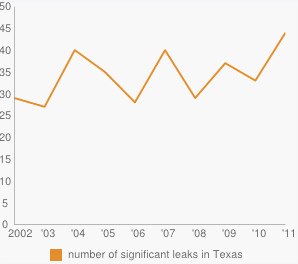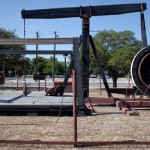Moving Crude Relies on Aging Pipeline System
 When Jed Clampett was “shootin’ at some food and up through the ground came a bubblin’ crude,” TV viewers might have thought it was funny. But as it turns out, some of crude oil pipelines in use today in the United States were built about the same time The Beverly Hillbillies hit the air on CBS in 1962. And when the crude comes bubblin’ up from pipelines now? It’s not so funny.
When Jed Clampett was “shootin’ at some food and up through the ground came a bubblin’ crude,” TV viewers might have thought it was funny. But as it turns out, some of crude oil pipelines in use today in the United States were built about the same time The Beverly Hillbillies hit the air on CBS in 1962. And when the crude comes bubblin’ up from pipelines now? It’s not so funny.
“In 2010, several systems that remain in service today already exceeded 50 years in age, with no major plans to retire existing infrastructure based on … age alone,” said a panel of pipeline executives in “Crude Oil Infrastructure“, a report to the National Petroleum Council. The panel warned that while age doesn’t always matter, “integrity issues,” including corrosion and failure of welded seams, “will become more common due to a number of age-related issues.”
Old Pipelines, New Direction
The age issue has come up as the pipeline industry undergoes a major shift in the direction of crude oil piped through Texas. Imported oil once arrived along the Gulf Coast and was then piped northward. Now, with domestic production increasing in states including Texas, Oklahoma, North Dakota and also in Canada, the flow is reversing.

Dave Fehling/StateImpact
"Block Valve" station on Seaway Pipeline allows operators to remotely shut off a section of the pipeline if there's a rupture
“We used to send oil to the mid-continent region for refining and distribution and development for product,” says Edward Hirs, an oil and gas economist who teaches at the University of Houston. Now, says Hirs, “They’ve turned these pipelines around and are now sending crude oil south to us.”
One of those “reversed” pipelines that’s approaching middle age runs right past two of the biggest cities in Texas.
“This pipeline is at least three decades old,” said Rita Beving in Dallas, talking about the Seaway Crude Pipeline. The interstate pipeline runs 500 miles from the Gulf Coast at Freeport, Texas to a huge oil depot in Cushing, Oklahoma. Its route skirts Houston’s western suburbs, then dodges Dallas on that city’s east side.

Courtesy Rita Beving
Rita Beving in Dallas is critical of the Seaway pipeline
“The Seaway line is running near schools, it’s running near residential areas, it is running near major water supplies for the Dallas-Fort Worth area,” Beving tells StateImpact Texas.
Beving, a community organizer with the corporate watchdog group Public Citizen, expresses concerns whether the Seaway pipeline’s 36 years of service means it’s at risk as it handles the “heavy crude” from Canada.
Those are some of the same worries often heard about the Keystone XL Pipeline: that the crude extracted from the tar sands of Canada is more corrosive than other types of crude, raising the risk of leaks. The Keystone XL line would run from Canada to Texas, but unlike the Seaway line, Keystone XL would be brand new.

Leading causes of Texas pipeline spills 2001-2012 according to data from the federal Pipeline and Hazardous Materials Safety Administration/Graphic by Yan Lu
Canadian Crude and Corrosion
While the industry has steadfastly maintained that Canadian crude is no more corrosive than other heavy crude, a major spill in Michigan involving a 43-year old pipeline speaks to the age issue. The Line 6B pipeline owned by Canada’s Enbridge Energy cracked open in the summer of 2010, spilling 840,000 gallons of Canadian crude oil into the Kalamazoo River.

NTSB
Ruptured pipeline spilled crude into Michigan's Kalamazoo River in 2010
Enbridge is also co-owner of the Seaway line (along with Houston’s Enterprise Products).
In a “Notice of Probable Violation” letter to Enbridge, the Pipeline and Hazardous Materials Safety Administration (PHMSA) said the company knew a weld on a seam had shown significant corrosion back in 2004, but did nothing about it as required by law. The seam broke, resulting in the big spill.
PHMSA said that Enbridge was good about doing inspections using a device that goes inside the pipeline but didn’t “integrate (the results) in a fashion that assures pipeline integrity.”
Congress has ordered up a broader investigation by the National Academy of Sciences to determine if Canadian crude poses a unique hazard to pipeline systems. The report to Congress is expected by next July.
In a statement to a Dallas TV station, the Seaway Crude Pipeline company said Canadian crude posed no increased risk, nor did the age of the pipeline. It said pipelines “can remain in service indefinitely” as long as they’re maintained and monitored properly.
Bigger in Texas
An even bigger spill than the one in Michigan occurred in Texas but apparently received little attention. StateImpact Texas came across it in a review of federal data on crude spills.
In January 2008, a pipeline ruptured near Denver City, a town of about 4,000 people in West Texas. According to the data, the rupture spewed some 1.3 million gallons of crude over a 24-hour period apparently before the company, ConocoPhillips, shut it down. The leak was mentioned in a Houston Chronicle article in 2010 that suggested the pipe was possibly 60 years old and that age might have played a role in the “unpublicized accident.”

Leaks of hazardous liquids from pipelines hit a high last year in Texas. Source: U.S. Pipeline and Hazardous Materials Safety Administration/Graphic by Yan Lu
PHMSA spill data tracks all leaks from pipelines including big “trunk” lines like the Seaway line as well as smaller “gathering” lines that run from wells and storage tanks to the trunk lines.
In 2011, that data showed Texas had more “significant” leaks of hazardous liquids including crude than in any year since 2002 (a significant leak would be more than 2,100 gallons of crude).
The state of Texas’s Railroad Commission (RRC) doesn’t regulate interstate pipelines like Seaway but does oversee intrastate lines and is responsible for overseeing clean up of crude pipeline spills. In an email to StateImpact Texas, the RRC media liaison, Ramona Nye, said “most reported spills appear to involve storage tank batteries and not pipelines”.
Texas has by far the most miles of pipeline carrying hazardous liquids in the nation and likewise, the most spills according to PHMSA data.

